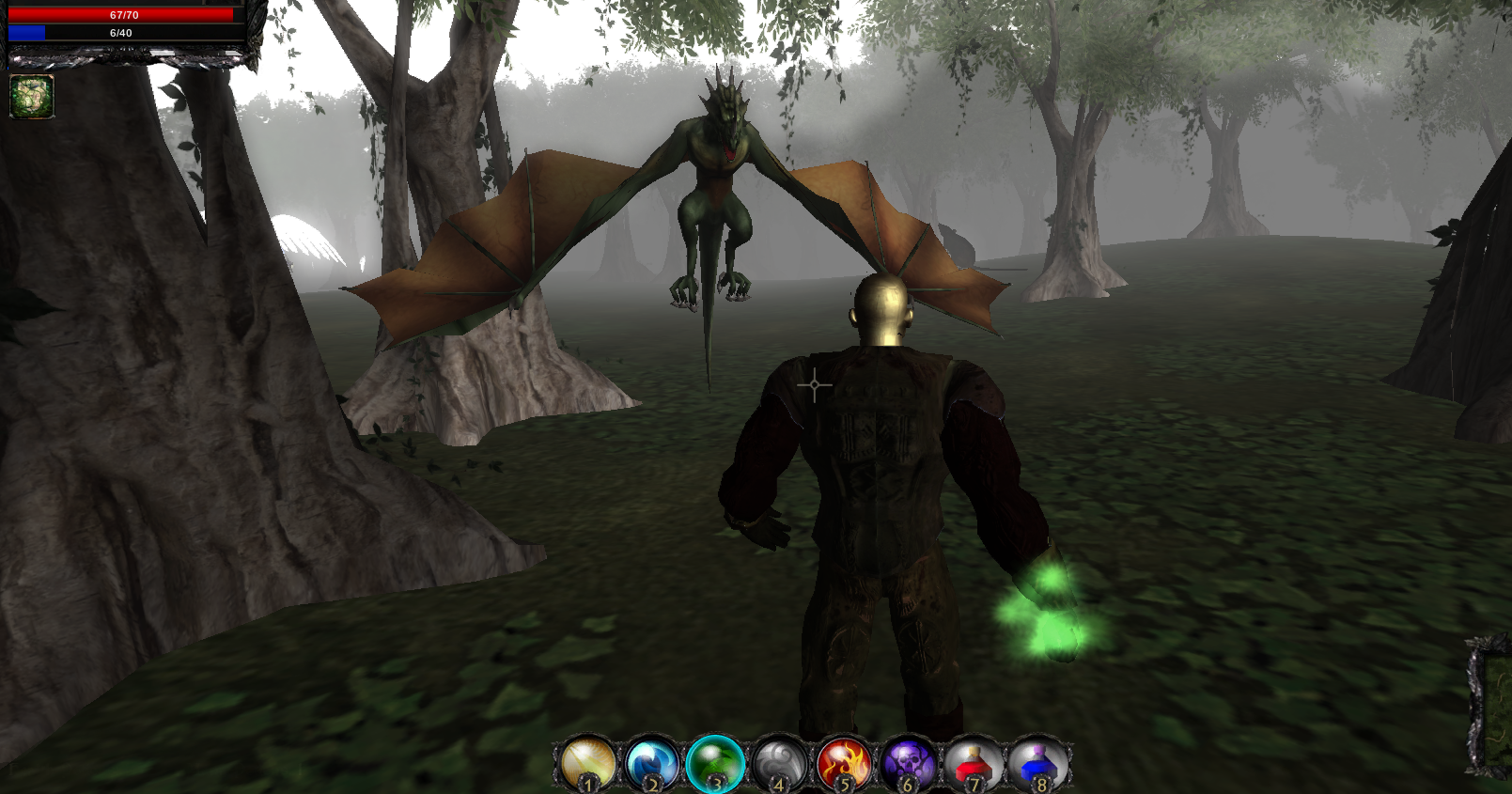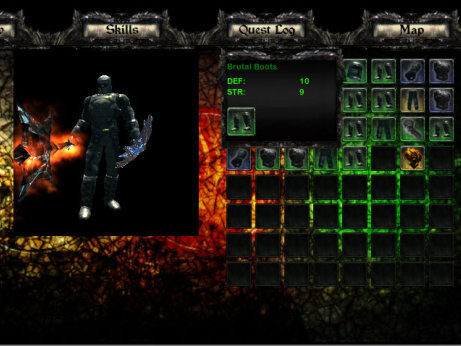Gate of Redemption was an ambitious capstone project I worked on during my time as a graduate student in Game Design at Northeastern University. It is a large, open-world 3D role-playing-game made in Unity. It was an attempt to incorporate as much as I could from what I learned during my time at Northeastern and NMSU while featuring many of the things I personally enjoy most in video games — exploration, deep lore, and strategic combat. It was originally published in the now defunct Unity Web Player and entered into a Unity game contest on the once popular online game website Kongregate.

Overview
I began work on this project about midway through my Game Design master’s program. It was to serve as my capstone project, the program’s equivalent of a thesis. One of my game design professors, Seth Sivak (now VP of Development on World of Warcraft at Blizzard Entertainment), served as my advisor. Whenever applicable, I worked on different aspects of the game and accompanying website for class projects and spent a majority of my free time on it. When I wasn’t working a part-time job or at the gym, I split my time between texturing, animating, 3D modeling, sound design, and programming. Because of the large scope, I utilized as many free and paid assets as I could, so long as I could retrofit them to suit my needs and the art style of the game.
So… What exactly was Gate of Redemption?
Basically, this was my dream game. Influenced heavily by ARPGs and MMORPG’s I played in my youth, it was an exploration-heavy role-playing game with a dark medieval fantasy theme. I wanted to recapture the excitement I felt exploring the vast open worlds of games like Everquest, and the thrill of uncovering secrets in games like Legend of Zelda. The art style was influenced by my own painting style, and by gothic-themed games like Castlevania.

The game not only looked pretty for the time (in my opinion), but it was filled with many secrets, rare items, strange monsters, action combat, and a story involving a fantastical afterlife world. I was going at it alone, and with a student’s budget, but I wasn’t going to let that stop me!
What I Did
The game contained all the general functionality you’d expect: saving/loading, menus, maps, quests, and a tutorial. It was a full role-playing-game with interactive signs and objects, NPC’s you could talk to, items you can collect and equip, and more. Players could scroll with the mouse wheel to switch between third and first person views or zoom in and out. The character movement felt good, and the combat system allowed for some strategy.

The action combat system was fairly simple, and involved attacking and blocking using the mouse buttons and casting various spells using the keyboard. What made it more interesting was that it included an “elemental weakness” system in the vein of Pokemon. Using number keys, you could change the character’s “elemental affinity,” granting you a different spell, increasing or decreasing your own elemental resistances, and causing your equipped weapon to do a different type of elemental damage. There was a combo system where switching between elements, blocking, attacking, and casting spells in specific orders allowed you to unleash powerful attacks or beneficial healing spells.

A World to Explore
As an enjoyer of RPGs and MMORPGs, I love finding new secrets, spotting rare creatures and finding unique equipment. Its easy to get lost in these types of worlds and completely forget about the main quest! Of course, I wanted to capture this experience in my own game too.
I built several gameplay mechanics to help facilitate exploration. First, it was important to me that players could swim and explore underwater, so I made that a priority. Second, I always enjoyed it when games let you dig into the ground to find secrets, so I implemented a terrain deformation system that allowed me to hide treasures underneath the landscape itself. I also added destructible trees, crates, and other objects.
At night in the game the landscape shifted into a Hellish place. Trees became withered or disappeared, water became lava, and regular animals were replaced by ghouls, skeletons and demons. Each area was essentially two, as the Hellish version had its own challenges to overcome and secrets to uncover.

What I Learned
My experience working on this game was invaluable. It was a deep dive into almost all parts of the development process and served as my gateway into programming and designing video games professionally.
I worked in Photoshop to make textures, backgrounds, icons and interface windows. I edited and recorded audio, made 3D models, added animations, wrote dialogue, and came up with lore. But mostly, I programmed and learned the ins-and-outs of working in Unity. I lived and breathed this game and thought about it even when I wasn’t in front of the computer.
Publication and Reception
In my final year at Northeastern I ramped up development of the game. It wasn’t exactly where I wanted it to be, but I needed to graduate! I wrapped things up as best I could and uploaded Gate of Redemption to the gaming website Kongregate, which had just begun to feature games made for the Unity Web Player. My comrades at Northeastern University also featured the game on the department’s homepage. Gate of Redemption received a hefty amount of plays on both platforms. Reviews were mostly positive, as many were wowed that such a game could be played in a browser and enjoyed some of the unique features. However, there were complaints about performance issues and some incomplete content.

I eventually took the game down due to a steep reduction in page hits and complications with the Unity Web Player. I did go back and attempt to optimize the game, creating a new starting area that was smaller and more manageable, removing excess post-processing effects and particle effects, fixing bugs, etc. However, as time passed and life because busier, I found it hard to spend as much time on such a large game. Furthermore, the Unity game engine was rapidly changing and I reached a point where I had trouble even opening my old project files. Ultimately, I decided to focus on other projects and my new career at the Learning Games Lab at NMSU.
What I’d Do Differently
Narrow the scope. As a student eager to learn and very excited to implement lots of cool features, I definitely went a little overboard. I had all kinds of systems in place, but they were not very well utilized or optimized. Many of the game’s features had potential, especially the terrain deformation and combat system, but they needed to be play-tested, refined and expanded upon. Scope-creep was a real issue here.
Optimize. Performance was also sub-par and only fairly new gaming computers could even run it at a reasonable frame rate at the time of release — a big ask for a game that was playable in a web browser. Being a student who didn’t yet have professional game development experience (and again, very excited to implement and experiment with new features), I didn’t pay enough attention to hardware constraints. Deforming the terrain mesh was particularly taxing on machines at the time, briefly dipping the frame-rate down to nearly unplayable levels.
Focus on the core gameplay. Exploration was fun and the game had lots of unique features. But what about the core gameplay? Well, combat was… fine. Seeing your opponent’s strengths and weaknesses and being able to switch between elements to exploit them was satisfying. Blocking and weapon attacks were snappy, responsive, and felt pretty good. But you could essentially block infinitely, and some of the enemies did not have a strong indication that they were about to attack. Basic combat needed more work and additional animations. It also could have benefited from a stamina system to make balancing attacking and blocking require more strategy.
The combo system also had a lot of potential to add strategic depth, but I never got the chance to give them the amount of variation in the “finisher abilities” I’d planned.
Progression, in general, was also lacking. Within the first few character levels, players could switch between every element and already had an overwhelming amount of spells and combos — too many to keep track of. Itemization had a similar problem, as players got too many weapon and armor items too quickly, lessening the excitement of finding new treasures. This was something that could have been ironed out with more time, but just never happened. Of course, in retrospect, it is easy to see that this should have been high priority from the start. Nowadays, I always start with the core gameplay and iteratively refine, only expanding with bells and whistles as the scope of the project and timeline allows.
Summary
I used to look back at Gate of Redemption with disappointment, as it had never reached its full potential. I believe by simply shifting some of my priorities I could have created a more successful game. I also believe that if I had made greater efforts to seek financial backing through crowd-funding or some other means I would have been able to dedicate more time to it after graduating and it could have morphed into something really special.
Of course, while it is easy to dwell on what could have been, I’ve since come to see it for what it is: an invaluable and immensely beneficial learning experience. In the years following this project, I’ve mostly worked on games that are not only smaller in scope, but that have had the support of a team. Gate of Redemption helped get me into professional game development and really helped hone my game design and programming skills. It also allowed me to explore many aspects of development and have a more well-rounded skillset. Furthermore, the game’s story, although pretty barebones in its original iteration, has heavily inspired the story and world of my upcoming work. The themes of religion, multi-dimensional travel, and the atmospheric fantasy aesthetic have also continued to permeate much of my personal work in games, writing, and art.
All that being said, I look forward to one day making the spiritual successor to Gate of Redemption. But my “dream game” of today is not the same as the one I had as a graduate student. Sure, the theming might be similar, and it may share similar mechanics. But the next game will have tighter, more refined gameplay, runs smoother and on more devices, and will be guided by years of experience.